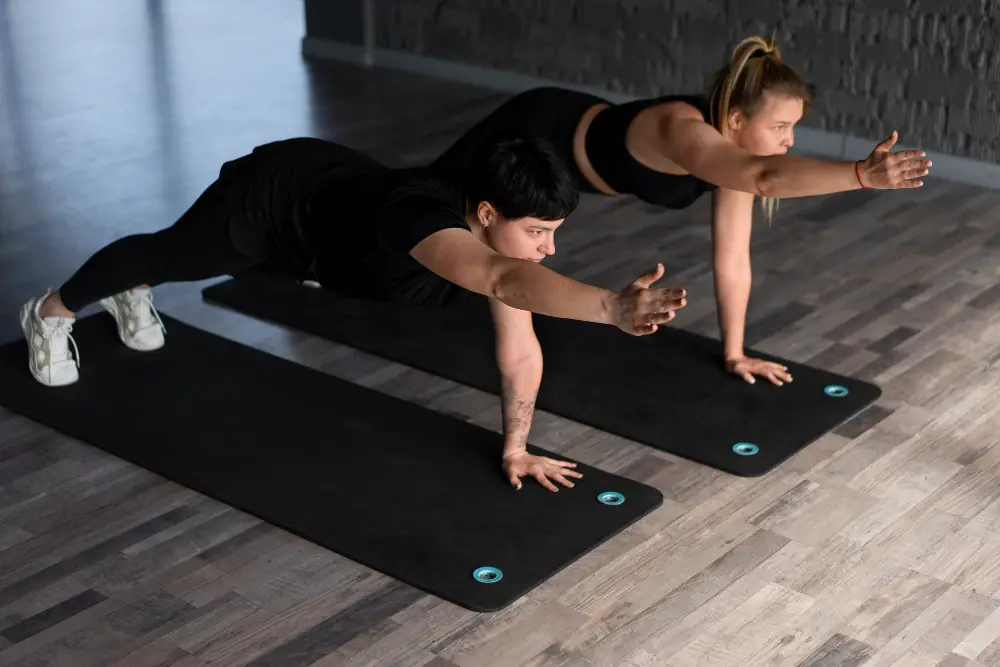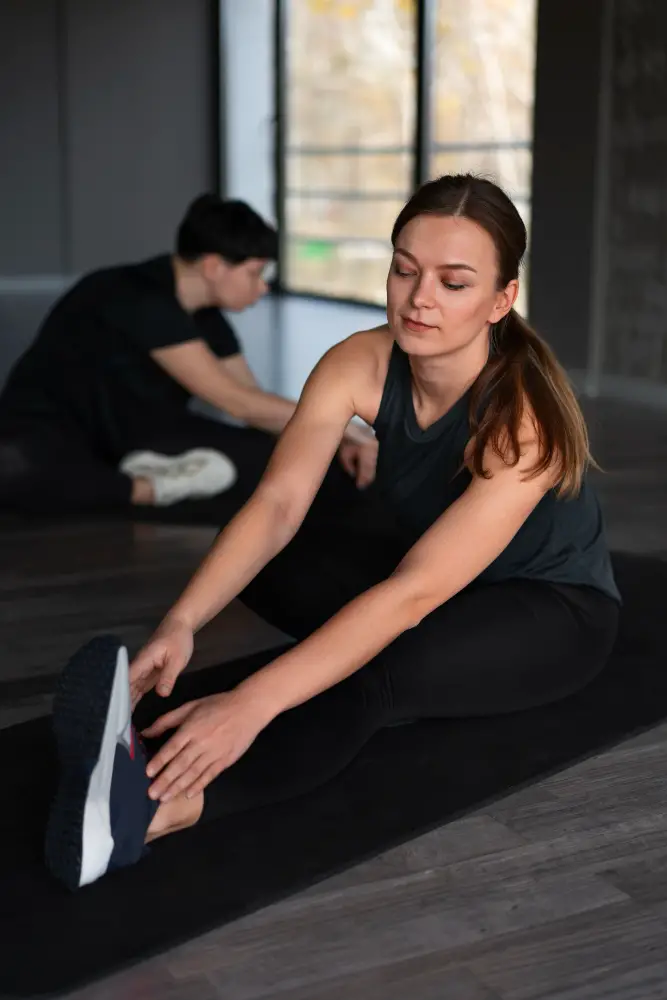Table of Contents
Introduction
Are you looking to start a new yoga practice that focuses on both the mind and body? Somatic yoga might be the perfect fit for you. Combining traditional yoga poses with mindful movement and breathwork; somatic yoga is an excellent way for beginners to connect with their bodies and reduce stress.
What is Somatic Yoga?
Somatic yoga is a unique blend of yoga and somatic practices that emphasizes awareness of the body’s sensations. It’s all about listening to your body and moving in a way that feels good. Unlike traditional yoga, which often focuses on achieving perfect poses, somatic yoga encourages you to tune into how each movement feels, promoting a deeper connection between the mind and body.
Benefits of Somatic Yoga
Somatic Yoga is a holistic practice that integrates the principles of somatic movement with traditional yoga poses and mindfulness techniques. Here are some of the key benefits:
- Improved Body Awareness: Somatic Yoga enhances the connection between the mind and body, increasing awareness of bodily sensations, movements, and postures. This heightened awareness can lead to better movement patterns and posture.
- Pain Relief: By focusing on gentle, mindful movements, Somatic Yoga can help alleviate chronic pain and tension in the body. It encourages the release of muscular tension and promotes relaxation.
- Increased Flexibility and Mobility: The practice involves slow, controlled movements that help to gently stretch and lengthen muscles, improving overall flexibility and joint mobility.
- Stress Reduction: The mindful aspect of Somatic Yoga promotes relaxation and reduces stress. The focus on breath and present-moment awareness helps to calm the nervous system and lower stress levels.
- Enhanced Healing: Somatic Yoga supports the body’s natural healing processes. It can be particularly beneficial for those recovering from injury or illness by promoting gentle, therapeutic movement.
- Better Posture and Alignment: Regular practice can improve posture and alignment by addressing imbalances and promoting a more functional movement pattern.
- Emotional Well-being: The integration of mindful movement with breathwork can help release stored emotions and trauma, leading to improved emotional health and resilience.
- Improved Coordination and Balance: The slow, mindful movements of Somatic Yoga enhance neuromuscular coordination, which can improve balance and prevent falls, especially in older adults.
- Greater Energy and Vitality: By relieving tension and promoting efficient movement, Somatic Yoga can increase overall energy levels and vitality.
- Mindfulness and Presence: The practice fosters a sense of mindfulness and presence, helping practitioners stay connected to the present moment and develop a deeper sense of inner peace and clarity.
Getting Started with Somatic Yoga
Starting with Somatic Yoga is a gentle and rewarding journey towards better body awareness and overall well-being. Here are some steps to help you get started:
- Understand the Basics: Familiarize yourself with the principles of Somatic Yoga, which combines gentle yoga poses with mindful movement and breath awareness. The focus is on exploring movements slowly and mindfully to increase body awareness.
- Find a Qualified Instructor: Look for a certified Somatic Yoga instructor who can guide you through the foundational practices and ensure you are performing the movements correctly. Many instructors offer both in-person and online classes.
- Create a Comfortable Space: Set up a quiet, comfortable space at home where you can practice without distractions. You don’t need much equipment – a yoga mat and some comfortable clothing are usually enough.
- Start with Basic Movements: Begin with simple, gentle movements to get a feel for the practice. Pay close attention to how your body feels and move slowly, focusing on the sensations in your muscles and joints.
- Focus on Breath: Integrate deep, mindful breathing into your practice. Inhale and exhale slowly, coordinating your breath with your movements. This helps to calm the nervous system and increase relaxation.
- Listen to Your Body: One of the key principles of Somatic Yoga is tuning into your body’s signals. Move within your comfort range and avoid pushing into pain or discomfort. The goal is to explore your body’s natural movements and release tension gently.
- Practice Regularly: Consistency is important. Aim to practice a few times a week, even if it’s just for a short session. Regular practice will help you build greater body awareness and improve your overall well-being.
- Incorporate Mindfulness: Pay attention to the present moment throughout your practice. Notice the sensations, thoughts, and emotions that arise without judgment. This mindfulness aspect can enhance the benefits of physical practice.
- Use Resources: Utilize books, videos, and online resources to deepen your understanding of Somatic Yoga. There are many guided practices available that can help you learn and progress at your own pace.
- Be Patient and Compassionate: Remember that Somatic Yoga is a journey, and progress may be gradual. Be patient with yourself and practice self-compassion. Celebrate the small improvements and enjoy the process of getting to know your body better.
By following these steps, you can begin your Somatic Yoga practice with confidence and start experiencing the numerous benefits it offers for both body and mind.
Basic Somatic Yoga Poses
Cat-Cow Stretch
This pose warms up the spine and increases flexibility.
- Start on your hands and knees in a tabletop position.
- Inhale, arch your back (cow pose).
- Exhale, round your back (cat pose).
Child’s Pose
A gentle stretch for the back, hips, and shoulders.
- Kneel on the floor and sit back on your heels.
- Stretch your arms forward and rest your forehead on the mat.
Somatic Bridge Pose
It engages the core and strengthens the back.
- Lie on your back with your knees bent and your feet on the floor.
- Lift your hips while squeezing your glutes.
Somatic Neck Release
Relieves tension in the neck and shoulders.
- Sit comfortably with your spine straight.
- Gently tilt your head to one side and hold.

Breathing Techniques in Somatic Yoga
Breathing techniques are a fundamental part of Somatic Yoga, helping to enhance relaxation, improve body awareness, and support the healing process. Here are some key breathing techniques used in Somatic Yoga:
- Diaphragmatic Breathing:
- Technique: Sit or lie down in a comfortable position. Place one hand on your chest and the other on your abdomen. Inhale deeply through your nose, allowing your abdomen to rise as the diaphragm fills with air. Exhale slowly through your mouth, feeling your abdomen fall.
- Benefits: This technique promotes relaxation, reduces stress, and improves oxygen exchange in the lungs.
- Three-Part Breath (Dirga Pranayama):
- Technique: Sit or lie down comfortably. Inhale deeply, first filling the lower lungs (abdomen expands), then the middle lungs (rib cage expands), and finally the upper lungs (chest rises). Exhale slowly, reversing the process: first release air from the upper lungs, then the middle, and finally the lower lungs.
- Benefits: This technique increases lung capacity, promotes full breathing, and helps calm the mind.
- Alternate Nostril Breathing (Nadi Shodhana):
- Technique: Sit comfortably with your spine straight. Use your right thumb to close your right nostril. Inhale deeply through your left nostril. Close your left nostril with your right ring finger and release your right nostril. Exhale through the right nostril. Inhale through the right nostril, close it with your thumb and exhale through the left nostril. This completes one cycle.
- Benefits: This technique balances the nervous system, improves focus, and reduces anxiety.
- 4-7-8 Breathing:
- Technique: Sit or lie down comfortably. Inhale quietly through your nose for a count of 4. Hold your breath for a count of 7. Exhale completely through your mouth, making a whoosh sound for a count of 8.
- Benefits: This technique helps to reduce stress, promote relaxation, and improve sleep quality.
- Ujjayi Breath (Ocean Breath):
- Technique: Inhale deeply through your nose, slightly constricting the back of your throat to create a gentle hissing sound. Exhale through your nose, maintaining the same constriction to produce the same sound. The breath should be smooth and even.
- Benefits: This technique helps to calm the mind, increase focus, and regulate the breath during movement.
- Sitali Breath (Cooling Breath):
- Technique: Sit comfortably and curl your tongue lengthwise to form a tube (if you can’t curl your tongue, purse your lips). Inhale deeply through the curled tongue or pursed lips, feeling the cool air enter your mouth. Close your mouth and exhale slowly through your nose.
- Benefits: This technique cools the body, reduces stress, and calms the mind.
- Box Breathing (Square Breathing):
- Technique: Sit or lie down comfortably. Inhale through your nose for a count of 4, hold the breath for a count of 4, exhale through your nose for a count of 4, and hold the breath out for a count of 4. Repeat the cycle.
- Benefits: This technique helps to reduce anxiety, improve concentration, and promote a sense of calm.
Mindfulness and Somatic Yoga
Importance of Mindfulness
Mindfulness is a crucial aspect of somatic yoga, helping you stay present and aware during your practice.
How to Practice Mindfulness
- Focus on your breath and body sensations.
- Observe thoughts without judgment.
- Return to your breath if your mind wanders.
Integrating Somatic Yoga into Daily Routine
Integrating Somatic Yoga into your daily routine can bring numerous benefits, from increased body awareness to reduced stress levels. Here are some practical steps to help you incorporate this practice into your everyday life:
- Start with a Morning Practice:
- Begin your day with a short Somatic Yoga session. Spend 10-15 minutes focusing on gentle movements and mindful breathing to wake up your body and mind.
- Example: Perform gentle neck rolls, shoulder shrugs, and spinal twists, followed by a few minutes of diaphragmatic breathing.
- Incorporate Mini-Sessions Throughout the Day:
- Take short breaks during your workday to practice Somatic Yoga. These mini-sessions can help relieve tension and improve focus.
- Example: Stand up, stretch your arms overhead, and take a few deep breaths. Perform a seated cat-cow stretch or gentle seated twists.
- Use Mindful Movement in Daily Activities:
- Apply the principles of Somatic Yoga to your everyday movements. Move mindfully, paying attention to how your body feels and making small adjustments to improve comfort and alignment.
- Example: When walking, focus on the sensation of your feet touching the ground and the movement of your legs and hips. When sitting, adjust your posture to ensure your spine is aligned.
- Set Aside Time for an Evening Practice:
- Dedicate 15-20 minutes in the evening to a relaxing Somatic Yoga routine. This can help you unwind and prepare for a restful night’s sleep.
- Example: Practice gentle forward bends, hip openers, and leg stretches. Finish with a few minutes of 4-7-8 breathing or Sitali breath to promote relaxation.
- Create a Dedicated Practice Space:
- Set up a quiet, comfortable space at home where you can practice Somatic Yoga regularly. Having a designated area can make it easier to maintain a consistent practice.
- Example: Use a yoga mat, bolster, or blanket in a corner of your living room or bedroom. Keep any props you might need nearby.
- Incorporate Breathing Techniques:
- Practice mindful breathing techniques throughout the day to stay grounded and calm.
- Example: Use alternate nostril breathing (Nadi Shodhana) during a break or box breathing (Square Breathing) before a stressful meeting.
- Combine Somatic Yoga with Other Daily Routines:
- Integrate Somatic Yoga with activities you already do, such as your morning or evening routine.
- Example: Practice a few gentle stretches and mindful breathing exercises while waiting for your morning coffee to brew or before brushing your teeth at night.
- Listen to Your Body:
- Pay attention to your body’s signals and adjust your practice as needed. Somatic Yoga is about exploring and responding to your body’s needs, so be flexible with your routine.
- Example: If you feel particularly tense or fatigued, focus on restorative poses and gentle movements.
- Use Technology for Guidance:
- Utilize apps, online classes, or videos to guide your practice and provide structure. Many resources offer short sessions that fit easily into a busy schedule.
- Example: Follow a guided 10-minute Somatic Yoga session on a yoga app during a lunch break.
- Reflect and Journal:
- Take a few minutes each day to reflect on your practice and how it makes you feel. Journaling can help you track your progress and stay motivated.
- Example: Write down any changes you notice in your body awareness, stress levels, or overall well-being.
Common Mistakes to Avoid
Overstretching
Listen to your body and avoid pushing too hard into poses.
Improper Breathing
Focus on maintaining a steady and deep breath throughout your practice.
Conclusion
Somatic yoga is a gentle and mindful practice that offers numerous benefits for both the mind and body. By integrating somatic yoga into your routine, you can improve flexibility, reduce stress, and enhance overall well-being. So why not give it a try and experience the transformative effects for yourself?
Related Article: Transform Your Life with Adult Yoga Classes







